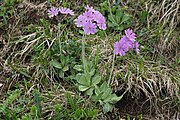Primula halleri, the long-flowered primrose, is a species of flowering plant in the family Primulaceae, native to the Alps, Carpathians, and some of the mountain ranges of the Balkan Peninsula.[1][2] A perennial, it is found at elevations of 1,500 to 2,700 m (4,900 to 8,900 ft).[3] Its main pollinator is the hummingbird hawk-moth Macroglossum stellatarum.[4]
| Primula halleri | |
|---|---|

| |
| Habit | |

| |
| Botanical illustration | |
| Scientific classification | |
| Kingdom: | Plantae |
| Clade: | Tracheophytes |
| Clade: | Angiosperms |
| Clade: | Eudicots |
| Clade: | Asterids |
| Order: | Ericales |
| Family: | Primulaceae |
| Genus: | Primula |
| Species: | P. halleri
|
| Binomial name | |
| Primula halleri | |
| Synonyms[1] | |
|
List
| |
References
edit- ^ a b "Primula halleri J.F.Gmel". Plants of the World Online. Royal Botanic Gardens, Kew. Retrieved 27 August 2023.
- ^ "Primula halleri (PRIHA)". EPPO Global Database. European and Mediterranean Plant Protection Organization. 2023. Retrieved 27 August 2023.
- ^ Zhang, Li-Rui; Conti, Elena; Keller, Barbara; Nowak, Michael D. (2013). "Development of 12 Polymorphic Microsatellite Loci in the High Alpine Perennial Primula halleri (Primulaceae)". Applications in Plant Sciences. 1 (12). doi:10.3732/apps.1300052. PMC 4103119. PMID 25202506.
- ^ Vos, Jurriaan M.; Keller, Barbara; Isham, Samuel T.; Kelso, Sylvia; Conti, Elena (2012). "Reproductive implications of herkogamy in homostylous primroses: Variation during anthesis and reproductive assurance in alpine environments". Functional Ecology. 26 (4): 854–865. doi:10.1111/j.1365-2435.2012.02016.x.

